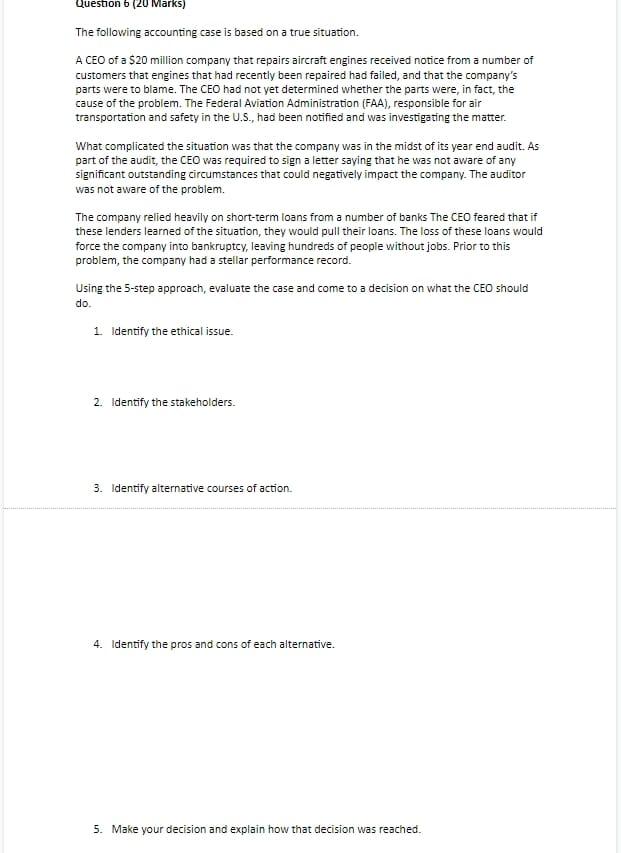
Question 6 (20 Marks) The following accounting case is based on a true situation. A CEO of a $20 million company that repairs aircraft engines received notice from a number of customers that engines that had recently been repaired had failed, and that the company's parts were to blame. The CEO had not yet determined whether the parts were, in fact, the cause of the problem. The Federal Aviation Administration (FAA), responsible for air transportation and safety in the U.S., had been notified and was investigating the matter. What complicated the situation was that the company was in the midst of its year end audit. As part of the audit, the CEO was required to sign a letter saying that he was not aware of any significant outstanding circumstances that could negatively impact the company. The auditor was not aware of the problem. The company relied heavily on short-term loans from a number of banks The CEO feared that if these lenders learned of the situation, they would pull their loans. The loss of these loans would force the company into bankruptcy, leaving hundreds of people without jobs. Prior to this problem, the company had a stellar performance record. Using the 5-step approach, evaluate the case and come to a decision on what the CEO should do. 1. Identify the ethical issue 2. Identify the stakeholders. 3. Identify alternative courses of action 4. Identify the pros and cons of each alternative. 5. Make your decision and explain how that decision was reached. Question 6 (20 Marks) The following accounting case is based on a true situation. A CEO of a $20 million company that repairs aircraft engines received notice from a number of customers that engines that had recently been repaired had failed, and that the company's parts were to blame. The CEO had not yet determined whether the parts were, in fact, the cause of the problem. The Federal Aviation Administration (FAA), responsible for air transportation and safety in the U.S., had been notified and was investigating the matter. What complicated the situation was that the company was in the midst of its year end audit. As part of the audit, the CEO was required to sign a letter saying that he was not aware of any significant outstanding circumstances that could negatively impact the company. The auditor was not aware of the problem. The company relied heavily on short-term loans from a number of banks The CEO feared that if these lenders learned of the situation, they would pull their loans. The loss of these loans would force the company into bankruptcy, leaving hundreds of people without jobs. Prior to this problem, the company had a stellar performance record. Using the 5-step approach, evaluate the case and come to a decision on what the CEO should do. 1. Identify the ethical issue 2. Identify the stakeholders. 3. Identify alternative courses of action 4. Identify the pros and cons of each alternative. 5. Make your decision and explain how that decision was reached







